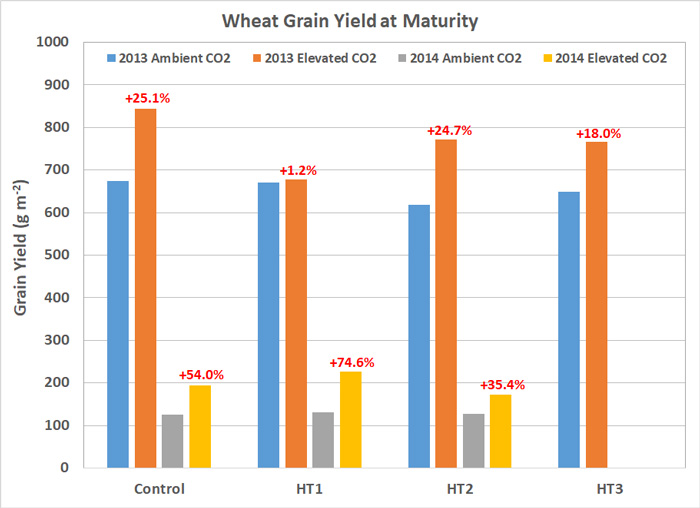| Tweet | Follow @co2science |
Paper Reviewed
Macabuhay, A., Houshmandfar, A., Nuttall, J., Fitzgerald, G.J., Tausz, M. and Tausz-Posch, S. 2018. Can elevated CO2 buffer the effects of heat waves on wheat in a dryland cropping system? Environmental and Experimental Botany 155: 578-588.
Noting that heat stress during key periods of the growing season has the potential to reduce crop yields and that climate models forecast increased heat waves in the future, Macabuhay et al. (2018) set out to investigate the effects of short-term (3-day) heatwaves on wheat growth.
Their work was conducted at the Australian Grains Free Air CO2 Enrichment facility in Horsham, Victoria, Australia, which is located in the semi-arid cropping region of south-eastern Australia's wheat belt. There, in both 2013 and 2014, the authors grew wheat (Triticum aestivum, cv. Yitpi) under two atmospheric CO2 concentrations (~390 ppm for ambient and ~550 ppm for elevated) and then subjected portions of the crops to one of three simulated heat waves at different stages of the growing season. The first heat wave was initiated on a subset of crops 5 days before anthesis (HT1), the second at 15 days post-anthesis (HT2) and the third at 30 days post-anthesis (HT3). Temperatures during the simulated heat waves averaged between 7 and 15°C above the normal (ambient) outside air temperature. Also of note, the 2013 growing season was relatively wet requiring no supplemental irrigation, whereas the 2014 season was relatively dry and required irrigation to keep the crops alive.
So what was the impact of elevated CO2 and the simulated heat waves on wheat growth and yield?
In terms of biomass, elevated CO2 increased aboveground biomass under control conditions (i.e., no heat wave applied) by 23.2 percent in 2013. This CO2-induced stimulation, however, was reduced to 11.7 percent when averaged over that reported for plants subjected to the three simulated heat waves. In 2014, the drier year of the study, aboveground biomass rose by a much larger 71.4 percent in response to elevated CO2 under control conditions. And that percentage stimulation was pretty much maintained under drought conditions, where the average aboveground biomass increase of plants in the three simulated heat wave treatments amounted to 69.1 percent.
Similar findings were reported for the all-important parameter of grain yield. As shown in the figure below, the grain yield increases due to elevated CO2 under control conditions was 25.1 and 54.0 percent in 2013 and 2014, respectively. Temperature stress from the heat waves reduced this yield stimulation to 14.6 percent in 2013, but maintained it at 55 percent in 2014.
In light of the above findings, it can be concluded that atmospheric CO2 enrichment positively impacts wheat growth and yield, even when growing conditions are less than ideal, as was the case here, where very high (7-15°C above normal air) temperatures reduced those benefits in one year (though the impacts were still positive), but maintained them in another.

Figure 1. Grain yield of wheat at maturity (for the 2013 and 2014 growing season) for crops grown under normal temperatures (Control; no heatwave) and short-term (3-day) simulated heat waves, initiated at either five days before anthesis (HT1), 15 days after anthesis (HT2) or 30 days after anthesis (HT3). The red-colored percentage values shown indicate the percent difference in grain yield due to elevated CO2 under control and each simulated heat wave condition. Data in this figure were obtained from the author's Table 2. Note that no third heat wave was applied in 2014.




